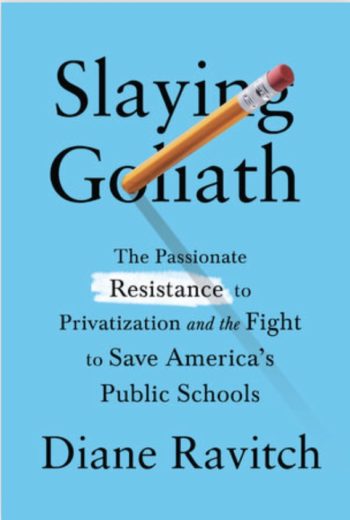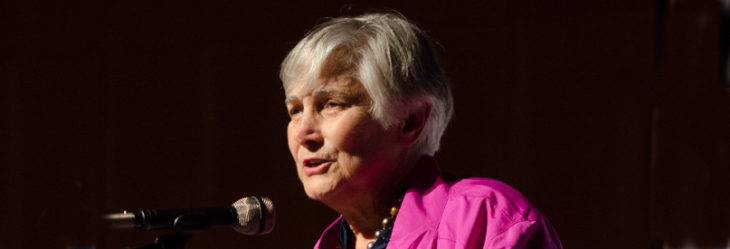By John Thompson.
Part One of Two.
Diane Ravitch’s Slaying Goliath: The Passionate Resistance to Privatization and the Fight to Save America’s Public Schools is the history of the rise and fall of corporate school reform, but it is much more. It isn’t that surprising that a scholar like Ravitch, like so many researchers and practitioners, predicted over a decade ago how data-driven, competition-driven “reform” would fail. Technocratic “reformers,” who Ravitch calls “Goliath,” started with a dubious hunch, that socio-engineering a “better teacher” could overcome poverty and inequality, and then ignored the science that explained why evaluating teachers based on test score growth would backfire.
 It may be surprising that Ravitch, an academic who had once worked in the Education Department of President George H. W. Bush, and served on the board of the conservative Fordham Foundation, become the leader of the grass roots uprising of parents, students, and educators which she dubs the “Resistance.” But it soon became clear why Ravitch inspired and guided the Resistance. In contrast to Goliath, who “ignored decades of research” and assumed the worst of their opponents, Ravitch respected and listened to practitioners and patrons.
It may be surprising that Ravitch, an academic who had once worked in the Education Department of President George H. W. Bush, and served on the board of the conservative Fordham Foundation, become the leader of the grass roots uprising of parents, students, and educators which she dubs the “Resistance.” But it soon became clear why Ravitch inspired and guided the Resistance. In contrast to Goliath, who “ignored decades of research” and assumed the worst of their opponents, Ravitch respected and listened to practitioners and patrons.
One big surprise, which is explained in Slaying Goliath, is how Ravitch presciently understood why output-driven, charter-driven reform devolved into “privatization.” She had firsthand experience with the hubris of the Billionaires Boys Club, understanding the danger of their desire to hurriedly “scale up” transformational change. And being an accomplished scholar, she had insights into how top-down technocrats’ embrace of behaviorism in the tradition of Edward Thorndike and B.F. Skinner, led to their commitment to “rigidly prescribed conditioning via punishments and rewards.”
Ravitch was among the first experts to fully grasp how, “Behaviorists, and the Disrupters who mimic them today, lack appreciation for the value of divergent thinking, and the creative potential of variety. And they emphatically discount mere ‘feelings.’”
Ravitch witnessed how corporate reformers “admire disruptive innovation, because high-tech businesses do it, so it must be good.” Rather than take the time to heed the wisdom of those who had no choice but to become Resisters, Goliath’s contempt for those in the classroom drove an evolution from “creative destruction” to “Corporate Disruption.”
Disrupters were in such a rush that they used children as “guinea pigs in experiments whose negative results are clear.” But they “never admit failure,” and remain oblivious to the fact that “The outcome of disruption was disruption, not better education.” And these billionaires not only continue to “fund a hobby injurious to the common good.” They’ve ramped up their assault on public education and its defenders, perpetuating a “direct assault on democracy.”
Ravitch predicts, “Historians will look back and wonder why so many wealthy people spent so much money in a vain attempt to disrupt and privatize public education and why they ignored income inequality and wealth inequality that were eating away at the vitals of American society.”
Just as she worked with and listened to educators, Ravitch worked with and listened to reformers who became Disrupters. She was in the room when the Sandia Report was presented. It showed that the Reagan administration’s “A Nation at Risk” was a “politically inspired hoax,” and a “manufactured crisis.” Ravitch witnessed the suppression of the report and the vilification of scholars who disproved the so-called “crisis in education” narrative.
In 1988, she and American Federation of Teachers President Al Shanker discussed his innovative idea for charter schools. They were supposed to be experiments in public schooling, in schools within schools, in “opt-for” schools, with the freedom from some regulations to allow experimentation, done with the consent and involvement of teachers. Ravitch saw how the idea was hijacked, so entrepreneurs could open charters, authorized by states, creating cultures of competition. Also, Southerners who had used choice in response to desegregation, brought it back under the “benign guise of consumerism.”
As the No Child Left Behind Act of 2002 started to undermine schooling, Ravitch joined progressive educator Deborah Meier in a dialogue which changed Ravitch, and the struggle against data-driven, competition-driven reforms. NCLB set impossible targets, such as 100% proficiency in 12 years for all schools. The incremental gains preceding NCLB on the reliable NAEP tests started to slow, and then they stagnated and declined when Secretary of Education Arne Duncan put NCLB’s punitive mindset on steroids.
In 2010, Ravitch met with Obama administration education leaders, discussing the untested Common Core national standards. She suggested grants for field studies in three to five states. The reply was, “We can’t wait. The standards must be in place by the 2012 elections.”
So, Duncan and philanthropists successfully pressured 45 states to adopt “the new standards, not because they were exceptionally good but because states were required to endorse common national standards … if they wanted to compete for a share of Race to the Top billions.” They “knowingly chose” high-stakes standards that most students would fail to meet. They pushed Common Core tests that had “truly bizarre“ cut scores on tests that students often had to pass to graduate. They used these inappropriate test results as the ammunition driving the equally untested, unreliable, and invalid value-added (VAM) algorithm for teacher evaluations. The resulting “VAM flop” was predictable, in large part, because, “Lovers of VAM ignored decades of research and assumed that teachers just didn’t want to be evaluated.”
Even worse, states were coerced into using dubious test score growth estimates in teacher evaluations, as billions of dollars were invested in charter expansion, using test scores as the metric for keeping score in this fight for the survival of schools. This also prompted massive cheating scandals, in addition to soul-killing teach-to-the-test. And, an audit by the US Department of Education documented charters’ “internal control weakness” that “represent financial risk … of waste, fraud, and abuse,” and charters “lack accountability over Federal funds” and “performance risk.”
Moreover, RttT-spawned evaluations were imposed during post-recession budget cuts, incentivizing the “exiting” of veteran teachers, who were horrified by the education malpractice they pushed, contributing to the extreme teacher shortage crisis. In 2018, teachers strikes erupted across the nation. These walkouts began in Red states where conservative legislatures further cut funding to under-resourced schools. Educators were motivated by terrible working conditions that meant awful learning conditions for students. They were resisting the disruption caused by corporate school reform, and the damage it had done to their kids. These teachers put up with “reform” as long as they could before joining the “Resistance.”
Ravitch explains:
If No Child Left Behind and Race to the Top had been business plans, the businesses would have quickly gone bankrupt because of their shabby treatment of their workers (teachers and principals). They failed because they were political attempts to remake education without any sense of what education is and should be. Politics and a failure of imagination kept these two bankrupt interventions on life support long after their failure was evident.
Much of Slaying Goliath describes the ways that Resisters rose up across the nation, opting out of tests; documenting invalid test questions (such as the one using the word “enjambment” in a MAP test for 9th grade); documenting the stress imposed on our youngest children who vomit and wet themselves due to testing (noting that the purpose of “vomit bags” was protecting tests, not anxious students); even trying to fire teachers based on test results of students who they didn’t teach; the insanity of Education Testing Services E-rater, “that doesn’t care if you say the War of 1812 started in 1945,”and the rushed gambles on digital systems that result in “depersonalized,” not personalized learning, and student revolts against Mark Zuckerberg’s great new idea, online instruction; and the Rhode Island students’ “Zombie March, “ as well as the “Take the Test” for 50 elected officials, architects, scientists, engineers, college professors, reporters, directors of nonprofit organizations, and reporters. (60% of the adult test takers didn’t score high enough to earn a diploma).
Ravitch observes that in contrast to the Resistance, “So as long as billionaires, hedge fund managers, and their allies are handing out money, there will be people lined up to take it. But their transactions cannot be confused with a social movement.” Moreover, “The most important lesson of the past few decades is that “Reform doesn’t mean reform. It means mass demoralization, chaos, and turmoil. Disruption does not produce better education.”
I’ll conclude this post with Ravitch’s words on the two dogmas that the Disruption movement relied on:
First, the benefits of standardization, and second, the power of markets. Their blind adherence to these principles has been disastrous in education. These principles don’t work in schools for the same reasons they don’t work for families, churches, and other institutions that function primarily on the basis of human interactions, not profits and losses.
A second post will go into more detail about how Slaying Goliath explains why high-stakes testing and mass expansion of charters were doomed to fail.
What do you think? Why did Goliath undertake the expensive hobby of school Disruption? How dangerous does it remain? What are the lessons to be learned from the Resistance?
Dr. John Thompson is an award-winning historian and an award-winning inner-city teacher. Now retired, he is the author of A Teacher’s Tale: Learning, Loving and Listening to Our Kids, which is being updated to be less academic and restore more students’ stories, as well as updating legal history research from the 1980s to 1990s.






Leave a Reply